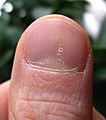Psoriasis facts for kids
Psoriasis is a common skin condition. It causes patches of skin that can look red, scaly, and sometimes itchy. This happens because skin cells grow much faster than usual. These extra cells build up on the surface, forming thick, silvery patches. Psoriasis can be mild, with just a few small spots, or it can cover larger areas of the body.
Many experts believe psoriasis is a genetic condition. This means it can run in families. It often gets triggered by things in the environment. There is no known cure for psoriasis, but different treatments can help manage the symptoms and make people feel better.
The word "psoriasis" comes from the Greek word "psoriasis." It means "itching condition" or "being itchy."
Contents
History of Psoriasis
Psoriasis might have been first described in Ancient Rome by a person named Cornelius Celsus. Later, in 1813, a British skin doctor named Thomas Bateman noticed a possible link between psoriasis and joint pain, which is now known as psoriatic arthritis.
During World War II, Admiral William Halsey got psoriasis while at sea. Because of this, he missed the important Battle of Midway. Admiral Chester Nimitz ordered him to recover in a hospital in Hawaii.
In the past, some treatments for psoriasis were not very effective and could even be harmful. In the 1700s and 1800s, doctors sometimes used substances like coal tars. These were often used with ultraviolet light. In the early 1900s, some cases of joint pain related to psoriasis were treated with gold preparations.
Signs and Symptoms
Psoriasis can show up in different ways on the skin.
Plaque Psoriasis
The most common type is called plaque psoriasis. About 85% to 90% of people with psoriasis have this form. Plaque psoriasis usually looks like raised areas of inflamed skin. These areas are covered with silvery-white, scaly skin. They are called plaques. You can often find these plaques on the elbows, knees, scalp, and back.
Other Types of Psoriasis
About 10% of people with psoriasis have other types. These include pustular psoriasis, which has small pus-filled bumps, and guttate psoriasis, which causes small, drop-shaped spots. There are also inverse psoriasis, which appears in skin folds, and other less common forms.
Diagnosis
Doctors usually diagnose psoriasis by looking at the skin. The typical signs are scaly, red patches or spots that might be painful or itchy. Usually, no special blood tests are needed to figure out if someone has psoriasis.
If a doctor is not sure, they might take a small sample of skin. This is called a biopsy. They look at the sample under a microscope to confirm the diagnosis. This also helps to make sure it's not another skin condition.
Causes of Psoriasis
The exact cause of psoriasis is not fully understood. However, several things are thought to play a role. These include genetics, changes in seasons, skin damage, and certain infections. Some medications can also be connected to different types of psoriasis.
Genetics
About one-third of people with psoriasis say that someone else in their family also has the condition. Researchers have found specific genes that are linked to psoriasis. This suggests that family history can increase the chance of getting it.
Lifestyle Factors
Some things can make psoriasis worse. These include long-term infections, stress, and changes in the season or climate. Other factors that might make the condition worse include hot water, scratching the skin patches, and dry skin.
Microbes
Sometimes, psoriasis can appear after a strep throat infection. It might also get worse if certain bacteria or fungi are present on the skin or in the gut. Guttate psoriasis, which often affects children and teenagers, can be triggered by a recent group A streptococcal infection, like tonsillitis.
Research
Scientists are always learning more about psoriasis. They are studying how things like insulin resistance might be connected to the condition. Early research also suggests that some natural substances, like polyphenols, might help with the inflammation seen in psoriasis.
Images for kids
See also
 In Spanish: Psoriasis para niños
In Spanish: Psoriasis para niños



